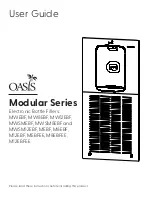
X-Array™ Loudspeaker Systems
will come out of the track once it is aligned with
the center cutout. For added safety, the locking
pin has a special shape which engages with the
track to prevent it from vibrating out of the track
hole during use. If the locking-pin knob seems
difficult to pull out when removing the hinge,
wiggle the hinge base while pulling out on the
knob. When the hinge locking pin is centered
in the track hole, the pin will easily release.
Xrhl Linking Hinge: Two Xrhl linking hinges
are used to link a pair of X-Array™ enclosures
together at their adjacent back corners. Each
linking hinge consists of two precision-machined
steel bases connected by a heavy-duty steel
hinge, as shown in
Figure 4b
. The hinge arms
pivot, allowing the enclosures to pivot at their
back corners. Each linking-hinge base has a lock-
ing pin which locks the hinge in place horizontally
in the rear track of the enclosure. (See section
3.
Rigging-Strength Ratings, Safety Factors and
Special Considerations for a detailed discussion
of the structural strength of the linking hinges.)
An Xrhl linking hinge must be installed in the top
and bottom enclosures simultaneously. The link-
ing hinges must also be used in pairs and in-
stalled with the hinge arms near the ends of the
rigging track as shown in
Figure 5b
. (Note: If one
linking hinge is installed incorrectly with the hinge
arms at the center of the track, the second linking
hinge will not fit into the track cutout.) Key dimen-
sions for the Xrhl rigging hinges and the enclo-
sure are presented in
Figures 4b
and
5b.
To install an Xrhl into the track of a pair of enclo-
sures stacked one on top of the other, grasp both
of the hinge bases and firmly insert both of the
hinge bases simultaneously into the long center
cutouts in the track of both enclosures, pressing
in until both spring-loaded locking pins are fully
retracted. Then apply pressure to slide the hinge
bases sideways towards the end of the track until
both spring-loaded locking pins drop into the
hinge-locking-pin holes in the base of the track
on both enclosures. Once the locking pins are
fully engaged, the linking hinge bases will be
immovable in the track. ALWAYS CHECK TO
MAKE SURE THE LINKING-HINGE BASES ARE
SECURELY LOCKED INTO THE TRACK, AND
THAT THE LOCKING PINS ARE FULLY EN-
GAGED IN THE TRACK BEFORE LIFTING ANY
LOUDSPEAKER ENCLOSURES OVERHEAD.
To remove the Xrhl linking hinge, grasp both of
the locking-pin knobs and pull out while applying
pressure on the hinge to slide the hinge base
toward the long cutout at the center of the track.
The hinge base will come out of the track once
it is aligned with the center cutout. Like the grid
hinge, the locking pin has a special shape which
engages with the track to prevent it from vibrating
out of the track hole during use. If the locking-pin
knob seems difficult to pull out when removing the
hinge, wiggle the hinge base while pulling out on
the knob. When the hinge locking pin is centered
in the track hole, the pin will easily release.
Xrhp Pickup Hinge: Two Xrhp pickup hinges
are used to attach to the back of the top
X-Array™ enclosure in a column to lift the array
where no grid is used or where a custom grid that
is not X-Array™ compatible is used. Each pickup
hinge consists of a single precision-machined
steel base connected by an alloy-steel chain, as
shown in
Figure 4c
. The pickup-hinge base has a
locking pin which locks it in place when inserted
into the rear track of an X-Array™ enclosure.
Standard chain-link couplers or connectors can
be used to attach the 7.95-mm (5/16-in.) alloy-
steel chain of the Xrhp to standard rigging hard-
ware (such as shackles, other chains, wire-rope
slings, etc.), which are in turn secured to a cus-
tom grid or directly to the building structure. (See
section
3. Rigging-Strength Ratings, Safet Fac-
tors and Special Considerations for a detailed
discussion of the structural strength of the pickup
hinges.)
The pickup hinges must be used in pairs and in-
stalled with the chain near the ends of the track,
page 6











































